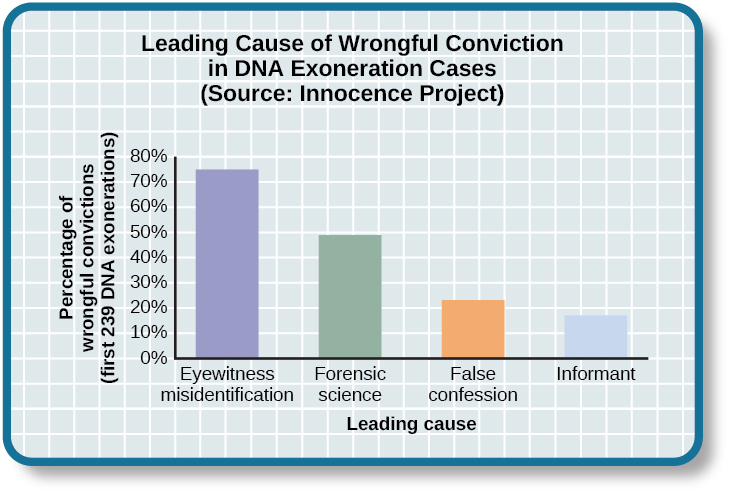| << Chapter < Page | Chapter >> Page > |
As illustrated by this example, we are vulnerable to the power of suggestion, simply based on something we see on the news. Or we can claim to remember something that in fact is only a suggestion someone made. It is the suggestion that is the cause of the false memory.
Even though memory and the process of reconstruction can be fragile, police officers, prosecutors, and the courts often rely on eyewitness identification and testimony in the prosecution of criminals. However, faulty eyewitness identification and testimony can lead to wrongful convictions ( [link] ).

How does this happen? In 1984, Jennifer Thompson, then a 22-year-old college student in North Carolina, was brutally raped at knifepoint. As she was being raped, she tried to memorize every detail of her rapist’s face and physical characteristics, vowing that if she survived, she would help get him convicted. After the police were contacted, a composite sketch was made of the suspect, and Jennifer was shown six photos. She chose two, one of which was of Ronald Cotton. After looking at the photos for 4–5 minutes, she said, “Yeah. This is the one,” and then she added, “I think this is the guy.” When questioned about this by the detective who asked, “You’re sure? Positive?” She said that it was him. Then she asked the detective if she did OK, and he reinforced her choice by telling her she did great. These kinds of unintended cues and suggestions by police officers can lead witnesses to identify the wrong suspect. The district attorney was concerned about her lack of certainty the first time, so she viewed a lineup of seven men. She said she was trying to decide between numbers 4 and 5, finally deciding that Cotton, number 5, “Looks most like him.” He was 22 years old.
By the time the trial began, Jennifer Thompson had absolutely no doubt that she was raped by Ronald Cotton. She testified at the court hearing, and her testimony was compelling enough that it helped convict him. How did she go from, “I think it’s the guy” and it “Looks most like him,” to such certainty? Gary Wells and Deah Quinlivan (2009) assert it’s suggestive police identification procedures, such as stacking lineups to make the defendant stand out, telling the witness which person to identify, and confirming witnesses choices by telling them “Good choice,” or “You picked the guy.”
After Cotton was convicted of the rape, he was sent to prison for life plus 50 years. After 4 years in prison, he was able to get a new trial. Jennifer Thompson once again testified against him. This time Ronald Cotton was given two life sentences. After serving 11 years in prison, DNA evidence finally demonstrated that Ronald Cotton did not commit the rape, was innocent, and had served over a decade in prison for a crime he did not commit.

Notification Switch
Would you like to follow the 'Psychology' conversation and receive update notifications?